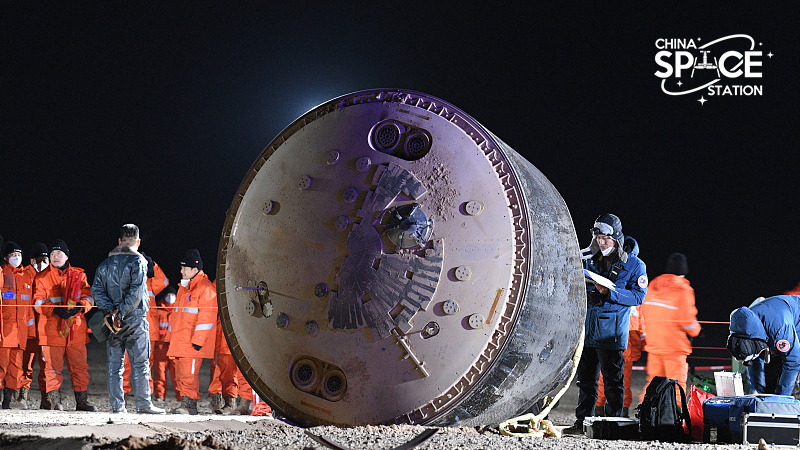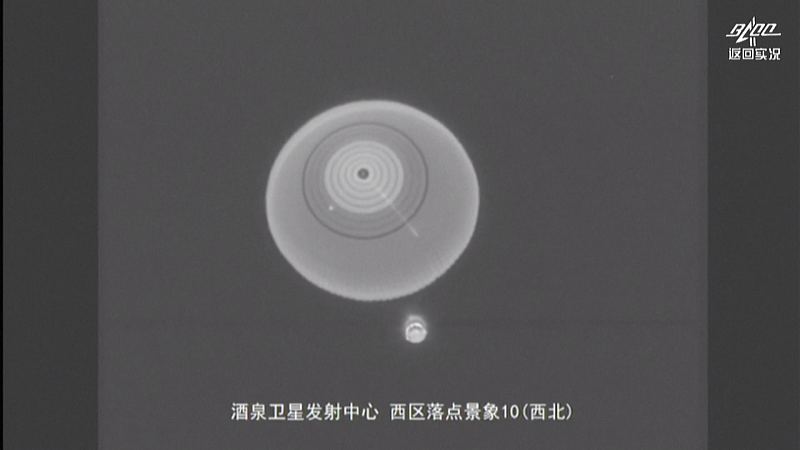
The bottom of the Shenzhou-14 spaceship is seen in the picture after it landed in north China's Inner Mongolia Autonomous Region, December 4, 2022. /CFP
The bottom of the Shenzhou-14 spaceship is seen in the picture after it landed in north China's Inner Mongolia Autonomous Region, December 4, 2022. /CFP
Editor's note: CGTN's China Space Station series provides a collection of in-depth stories and analysis about technologies used in China's first permanent space station, the crown jewel of the nation's space endeavors.
China innovated an array of technologies to make sure the Shenzhou-14 crewed spaceship returned safely to Earth on Monday.
Different from the previous mission, the reentry of the Shenzhou-14 spaceship was scheduled at night, which meant low temperatures and low visibility.
Thermal control system
The temperatures can be tricky.
From the moment the spaceship separated from the space station on the way home, it has to activate its own thermal control system to keep the temperature between 17 and 25 degrees Celsius, an ideal condition for the taikonauts.
The spaceship's thermal coatings and the insulation do not require powered equipment. It is also equipped with radiators and heaters generating power to keep the inside of the spaceship warm.
"If the reentry capsule landed in a dessert with a temperature of under minus 25 degree Celsius," said Peng Huakang, technical supervisor of the recovery team at the 5th Academy of Aerospace Science and Technology Group, "The temperature inside can be maintained at 15 degree Celsius for over an hour, with the hatch closed and ventilator shut."
01:09

When the spaceship reenters Earth' atmosphere, the friction can cause temperatures of over 1,000 degree Celsius, so the ship has a heat shield installed on its bottom to resist the high temperature.
High efficient communication
The ground teams including control center in Beijing, landing site and rescue teams use the BeiDou Navigation Satellite System to communicate with each other in real time to increase the efficiency of locating the reentry capsule.
The rescue helicopters also have a smart system installed to help predict the path of the reentry capsule during landing.

The parachutes of the Shenzhou-14 spaceship unfold before it lands safely in north China's Inner Mongolia Autonomous Region, December 4, 2022. /CMSA
The parachutes of the Shenzhou-14 spaceship unfold before it lands safely in north China's Inner Mongolia Autonomous Region, December 4, 2022. /CMSA
Triple parachutes
When the spaceship is 10 kilometers above the ground, the three parachutes will open one after another. The size of the parachutes will expand from only several square meters to over 1,000 square meters, gradually reducing the spaceship speed from 200 meters per second to seven meters per second, which protects taikonauts from G-force overload.
"It's like when we're driving, we need to slow down gradually," said Rong Wei, deputy chief designer of manned spaceship at the 5th Academy of Aerospace Science and Technology Group, "At the same time, the engine will be ready for a soft landing."
When the reentry capsule is only one meter above the ground, the thrust reverser will further down the spaceship speed to 1-2 meters per second.
"Plus we installed seat cushions for the taikonaut to mitigate the impact when they land and keep them safe," Peng said.